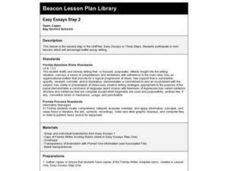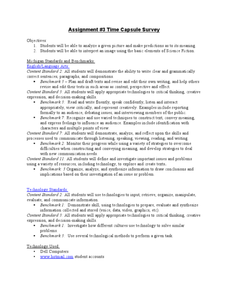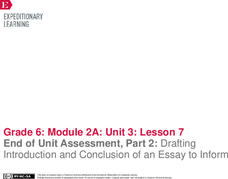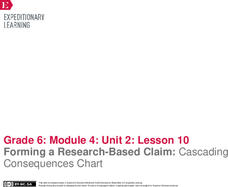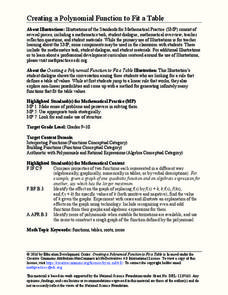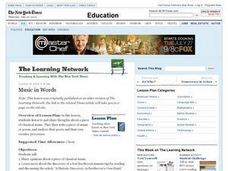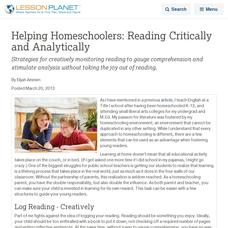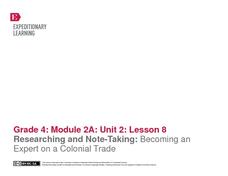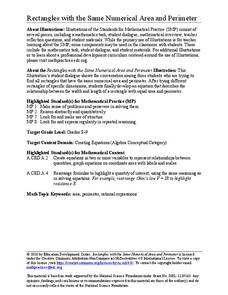Curated OER
Easy Essays Step 2
Third graders write essays after participating in mini-lessons that encourage better writing. They write using the model of a skeleton to which they add the muscles.
Ms. Amber Nakamura's Mathematics Website
Algebra Project
What would your dream house look like? A cottage? A medieval castle? High schoolers enrolled in Algebra design the perfect house while using slopes to write equations for various aspects of the project.
Curated OER
Time Capsule Survey
Here's a fun way to incorporate technology into your curriculum. E-mail each of your class members a picture and 10 questions about the photo. Individuals then imagine the story behind the image and e-mail back their responses. Although...
Curated OER
Check it Out...Nonfiction Can Be Fun!
Organizing information gathered for a research topic can be a challenge. Read aloud notes you have collected on a topic and use suggestions offer by the class to categorize and sort this information. Partners then follow this pattern,...
Curated OER
Critical Reading, Imaginative Writing and the Montage
Pupils discuss the difference between primary and secondary sources and consider how an exhibit is researched. They design and create a montage that reflects themselves in a social and historical context.
Curated OER
Reflecting on Learning Experience
Students internalize learning experience by writing about it.
Norfork School District
Habits of Mind
Why do artists create? To solve a problem, of course. Young artists work individually and then in groups to create observational, imaginative, and narrative drawings in response to an assignment that requires them to employ all 16 Habits...
EngageNY
End of Unit Assessment, Part 2: Drafting Introduction and Conclusion of an Essay to Inform
A powerful introduction and conclusion can really pack a punch. Using the resource, scholars first read and discuss a model essay. Then, as part of the end of unit assessment, they draft the introductory and concluding paragraphs of...
EngageNY
Forming a Research-Based Claim: Cascading Consequences Chart
Is it relevant? Scholars choose a resource from their folders and search for relevant information about the harmful and beneficial consequences of DDT. They mark benefits in one color and harmful effects with another color. They then add...
Education Development Center
Creating a Polynomial Function to Fit a Table
Discover relationships between linear and nonlinear functions. Initially, a set of data seems linear, but upon further exploration, pupils realize the data can model an infinite number of functions. Scholars use multiple representations...
Curated OER
Judging a Book by Its Cover
Students explore the relationship between the form of books and the content inside. For this book exploration lesson, students use a piece of their creative writing as inspiration; they author a written book and design a cover that...
Curated OER
Music in Words
Your class can build strong, well-represented opinions about the music they hear. They listen to, and share thoughts about, a piece of classical music. Then they write a piece of music or a poem, and analyze their peers' work and their...
C.S. Lewis Foundation
Educator’s Guide to The Lion, The Witch and the Wardrobe #1
Perfect for both classroom and homeschool settings, this 72-page resource packet, designed for C.S. Lewis's The Lion, The Witch and the Wardrobe, is a must-have for your curriculum library. Chapter-by-chapter vocabulary lists and...
Curated OER
Lesson: Skin Fruit: Ideas of Empathy in Janine Antoni's Work
Kids get artistic as they explore the impact of art materials, sculpture, and performance. They discuss the work of Janine Antoni and then create a performance piece that reflects social or global issues they feel strongly about. The end...
Curated OER
Helping Homeschoolers: Reading Critically and Analytically
Strategies for creatively monitoring reading to gauge comprehension and stimulate analysis without taking the joy out of reading.
Core Knowledge Foundation
Volume 2 - A History of the United States: Modern Times—Late 1800s to the 2000s
The second volume of the Core Knowledge History of the United States ebook begins by asking young scholars to consider the impact immigration, industrialization, and urbanization had on the United States in the late 1800s. The text ends...
EngageNY
Researching and Note-Taking: Becoming an Expert on a Colonial Trade
Fourth graders work in small groups to become experts on different colonial trades in the eighth instructional activity of this unit. Working toward the long-term goal of writing a piece of historical fiction, young scholars read...
Annenberg Foundation
Migrant Struggle
The American Dream is a goal that many pursue, but is it truly attainable for all people? An in-depth lesson explores the plight of migrants in twentieth-century America. The resource includes a video and author biographies and...
Curated OER
Comedy Across the Curriculum
The New York Times Learning Network provides the resources that permit pupils to examine and then write and perform a fake news broadcast in the vein of “The Daily Show” or “Saturday Night Live” Weekend Update. The generated reports...
Curated OER
Stringbean Coes Vacation
Third graders first begin the activity by reading Vera B. Williams Stringbean's Trip to the Shining Sea. This book is a collection of postcards that Stringbean Coe and his brother Fred write to their family while they were on a summer...
Curated OER
New Year Celebrations Around the Globe
Students view art images of Norman Rockwell's family traditions and celebrations. They search the internet for information, and complete reflective and creative writing and sketch assignments. Students recognize and name emotions shown...
Curated OER
Words Have Meaning
Learners interpret and analyze art for meaning and a Maya Angelou poem for meaning. In this art and literature analysis lesson, students analyze Alison Saar's "Lost and Found" and Maya Angelou's poem "Alone." Learners write creative...
Education Development Center
Making Sense of Unusual Results
Collaboration is the key for this equation-solving lesson. Learners solve a multi-step linear equation that requires using the distributive property. Within collaborative groups, scholars discuss multiple methods and troubleshoot mistakes.
Education Development Center
Rectangles with the Same Numerical Area and Perimeter
Is it possible for a rectangle to have the same area and perimeter? If you disregard units, it happens! In a challenging task, groups work to determine the rectangles that meet these criterion. The hope is that learners will naturally...


